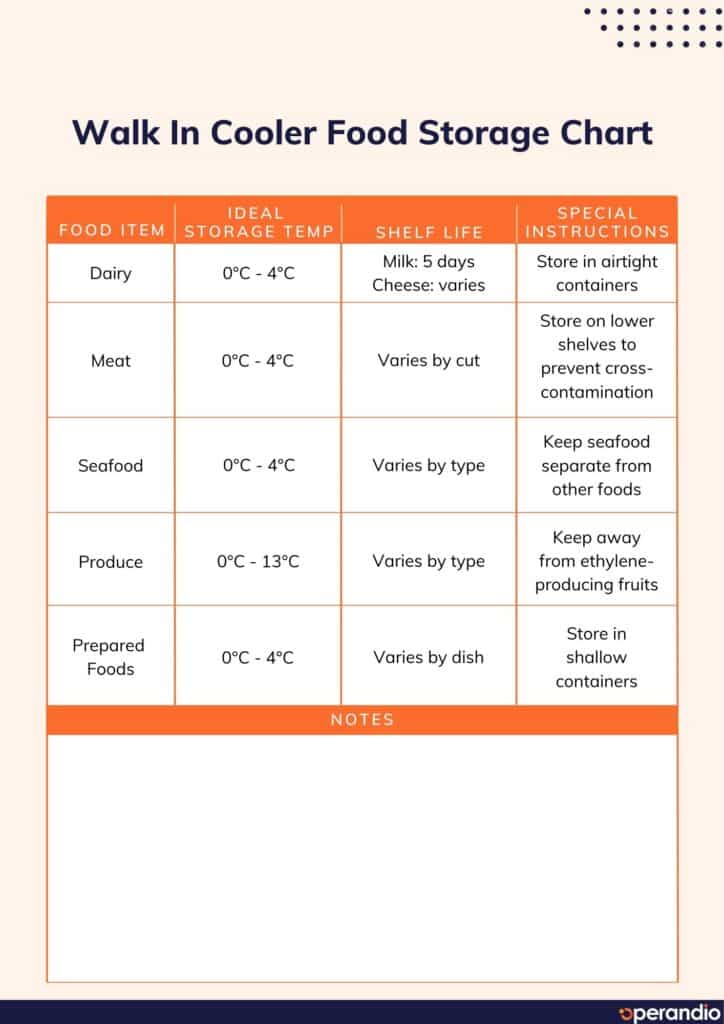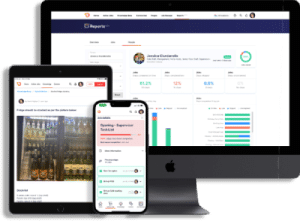Walk In Cooler Food Storage Chart
If you operate a business that prepares food, you need to store that food properly at the correct temperature. Keeping food stored at the correct temperature is important because it helps prevent the growth of harmful bacteria, which can cause foodborne illnesses. Bacteria thrive in warm environments, and if food is not stored at the proper temperature, bacteria can multiply rapidly, leading to the risk of food poisoning.
For example, if food is stored at temperatures above 4 °C, bacteria such as Salmonella and E. coli can grow quickly and cause foodborne illness. On the other hand, if food is stored at temperatures below 0 °C, it can freeze and lose its texture, flavor, and nutritional value.
Therefore, it is essential to store food at the correct temperature, which is where a walk in cooler food storage chart can help. This document provides food safety guidelines on how to correctly store food in your walk in cooler to ensure that your food is both good quality and safe for consumption.


What is a walk in cooler?
A walk-in cooler is a large, enclosed storage space used for keeping food and other perishable items cold. It is typically used in commercial kitchens, grocery stores, restaurants, and other foodservice establishments. The walk-in cooler is designed to maintain a consistent temperature and humidity level to preserve the quality and freshness of stored food items.
The cooler is called a “walk-in” because it is large enough for a person to walk into and move around inside to store and retrieve items. It is usually constructed of insulated panels, a floor, and a ceiling, which are designed to provide a cold, airtight environment. The temperature in a walk-in cooler can be controlled by a refrigeration system, which may be mounted on the ceiling or outside the cooler.
Walk-in coolers are available in a range of sizes, from small walk-ins for small businesses to large, custom-built walk-ins for larger commercial operations. They are typically used for storing perishable items such as fruits, vegetables, dairy products, meats, and seafood, but can also be used to store non-food items, such as flowers or medical supplies, that require a cool environment.
What does a walk in cooler food storage chart look like?
A walk-in cooler food storage chart is typically a table that provides guidelines on how to store different types of food in a walk-in cooler. The chart usually includes columns for different food categories, such as dairy, meat, seafood, produce, and prepared foods.
Here is an example of what a walk-in cooler food storage chart might look like:
| Food Item | Ideal Storage Temperature | Shelf Life | Special Instructions |
| Dairy | 0 °C – 4 °C | Milk: 5 daysCheese: varies | Store in airtight containers |
| Meat | 0 °C – 4 °C | Varies by cut | Store on lower shelves to prevent cross-contamination |
| Seafood | 0 °C – 4 °C | Varies by type | Keep seafood separate from other foods |
| Produce | 0 °C – 13°C | Varies by type | Keep away from ethylene-producing fruits |
| Prepared Foods | 0 °C – 4 °C | Varies by dish | Store in shallow containers |
How do I use a walk in cooler food storage chart?
Here are some steps on how to use a walk-in cooler food storage chart:
Review the chart
Before using the chart, take some time to review the information provided. Look for any special instructions or warnings related to specific types of foods.
Identify the type of food
Locate the food item you want to store on the chart. Different types of foods may have different storage requirements, so it’s essential to choose the correct one.
Determine the ideal storage temperature
Check the chart for the ideal temperature range for the food item. Most perishable foods should be stored at temperatures below 40°F (4 °C) to slow down bacterial growth and prevent spoilage.
Follow any additional instructions
The chart may provide additional instructions on how to store the food item, such as the ideal humidity level, recommended storage containers, or shelf life. Follow these instructions carefully to ensure proper storage.
Monitor the storage conditions
Once you have stored the food item, monitor the temperature and humidity levels regularly to ensure they remain within the recommended range. Adjust the temperature or humidity as needed to maintain the ideal conditions.
How can Operandio help me maintain the correct temperature in my walk in cooler?
Operandio’s automated temperature monitoring provides the tools necessary to keep track of the temperature inside your walk in cooler. It works by using wireless sensors to monitor the temperature of your walk-in cooler or freezer.
Here are the basic steps involved in how Operandio’s system works:
- You install Operandio’s wireless sensors in your walk-in cooler or freezer to monitor the temperature. The sensors are easy to install and designed to transmit data wirelessly.
- The data transmitted from the sensors is stored in the cloud, allowing you to access it remotely from any device with an internet connection.
- Alerts will notify you if the temperature in the cooler or freezer falls outside of the acceptable range. This ensures that you can take corrective action promptly to prevent spoilage or waste.
- You can use Operandio’s software to monitor and analyse the temperature data over time. This can help you identify trends or patterns that may indicate a problem with your cooling system, such as a malfunctioning compressor or a leak in the refrigerant line.
- You can generate reports on temperature data to provide documentation of compliance with food safety guidelines or to share with health inspectors or auditors.
Find out more or request a demo for Operandio today!
Try Operandio for free
Get started in less than 2 minutes.
By signing up, you accept the Subscription Agreement and Privacy Policy.
